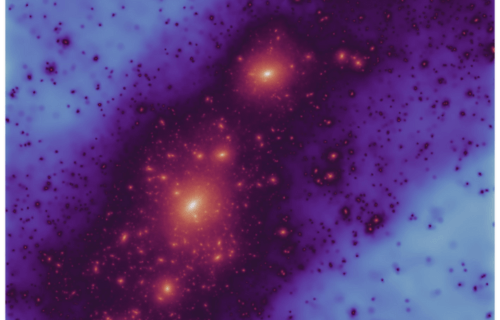DURHAM, United Kingdom — Orbiting our home galaxy, the Milky Way, is a vast number of satellite galaxies surrounding us in a rather bizarre pattern. Now, however, astronomers say they’re getting closer to understanding why they’re positioned in a strange formation.
Researchers at Durham University have a new theory for why faint satellite galaxies surrounding the Milky Way are arranged on an thin rotating plane called the “plane of satellites.” The alignment looks like a thin plane piercing the galaxy while, at the same time, circling a coherent and long-lived disk.
The bizarre alignment has puzzled scientists for years since its discovery in the 1970s. There is no physical mechanism to create the satellite plane. It was thought that satellite galaxies should be arranged in a roughly round configuration tracing the universe’s dark matter. However, supercomputer simulations of the plane have failed to recreate similar structures that could track the evolution of the universe since the beginning of the Big Bang. With no concrete or tangible proof, some researchers started to question the cold dark matter theory of galaxy formation.
Is this alignment just a fluke?
Similar to the way star constellations change, the international research team suggests the plane of satellites is just a cosmological quirk that will break down over time. Their model also explains how the galaxies we currently view are gradually formed with clumps of cold dark matter. Though it has never been seen with the human eye, dark matter is theorized to make up about 27 percent of the universe.
The current study’s conclusion came from new data from the European Space Agency’s GAIA space observatory. GAIA charts a six-dimensional map of the Milky Way and includes precise positions and measurements for about one billion stars in the galaxy — one percent in total — along with companion systems.
The data gave scientists orbital projections of past and future satellite galaxies. Their predictions showed the plane will form and dissolve in a few hundred million years. While it sounds like a lot, it’s a blink in cosmic time.
“The plane of satellites was truly mind boggling,” says study lead author Till Sawala, a professor at the University of Helsinki, in a media release. “It is perhaps unsurprising that a puzzle which has endured for almost fifty years required a combination of methods to solve it – and an international team to come together.”

Till Sawala/Sibelius collaboration)
Our neighboring galaxies are just at ‘the right place at the right time’
Scientists also searched for new tailor-made cosmological simulations for evidence of planes of satellites. Previous research on simulations failed to include the distances of satellites from the center of the galaxy, making virtual satellite systems look much rounder than real ones.
In the current study, they created several simulations of the Milky Way with all of them containing a plane of satellite galaxies similar to the ones seen in telescopes. The tailor-made virtual simulations are suggested to give more validity to the standard model of cosmology and to the theory that dark matter is the foundation behind the formation of our universe.
“Thanks to the amazing data from the GAIA satellite and the laws of Physics, we now know that the plane is just a chance alignment, a matter of being in the right place at the right time, just as the constellations of stars in the sky,” says Carlos Frenk, a professor of fundamental physics in the Institute for Computational Cosmology at Durham University. “Come back in a billion years, and the plane will have disintegrated, as will today’s constellations. It continues to provide a remarkably faithful description of the evolution of our Universe.”
The study is published in the journal Nature Astronomy.


A new theory to be touted as fact by the followers of the cult, false science..